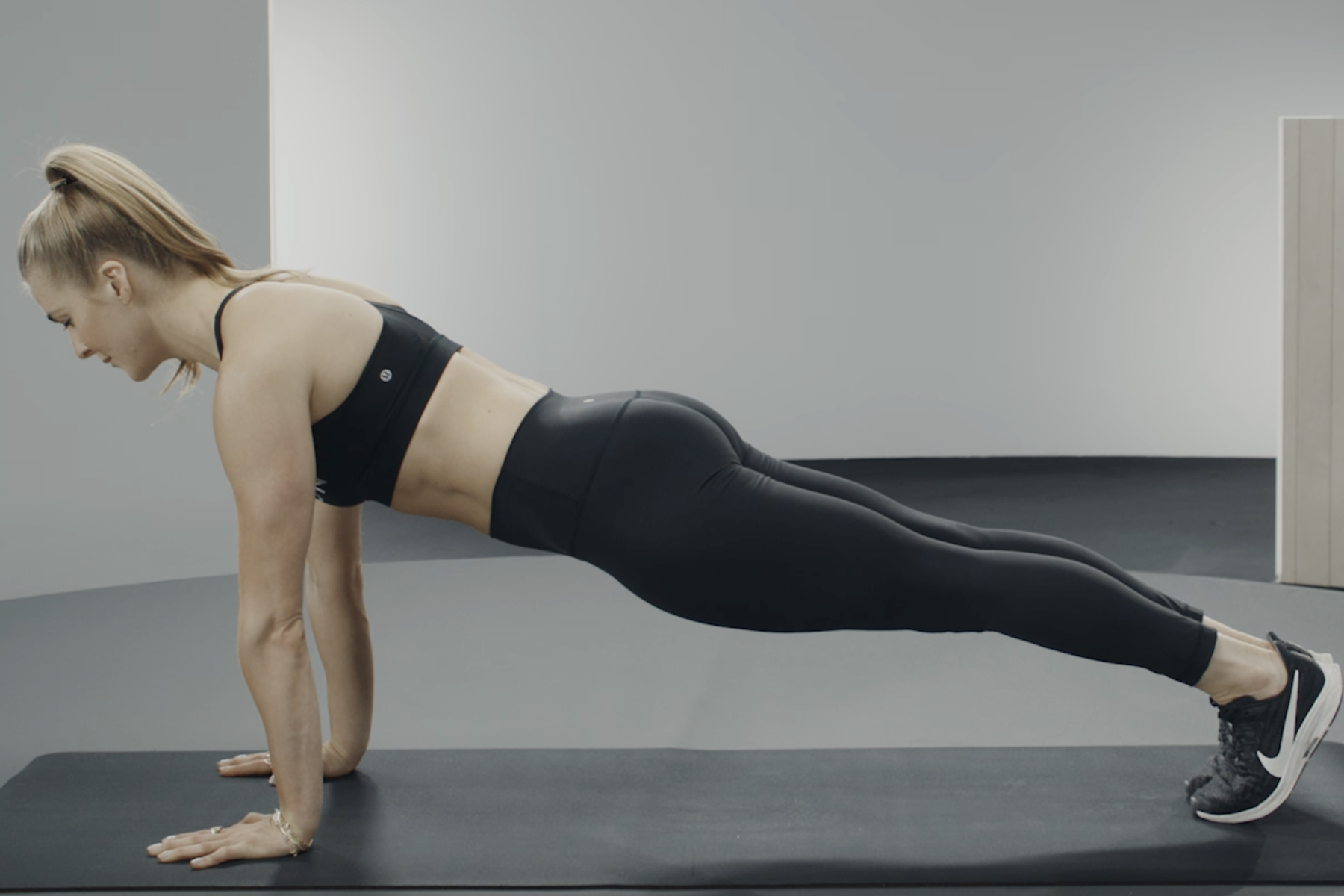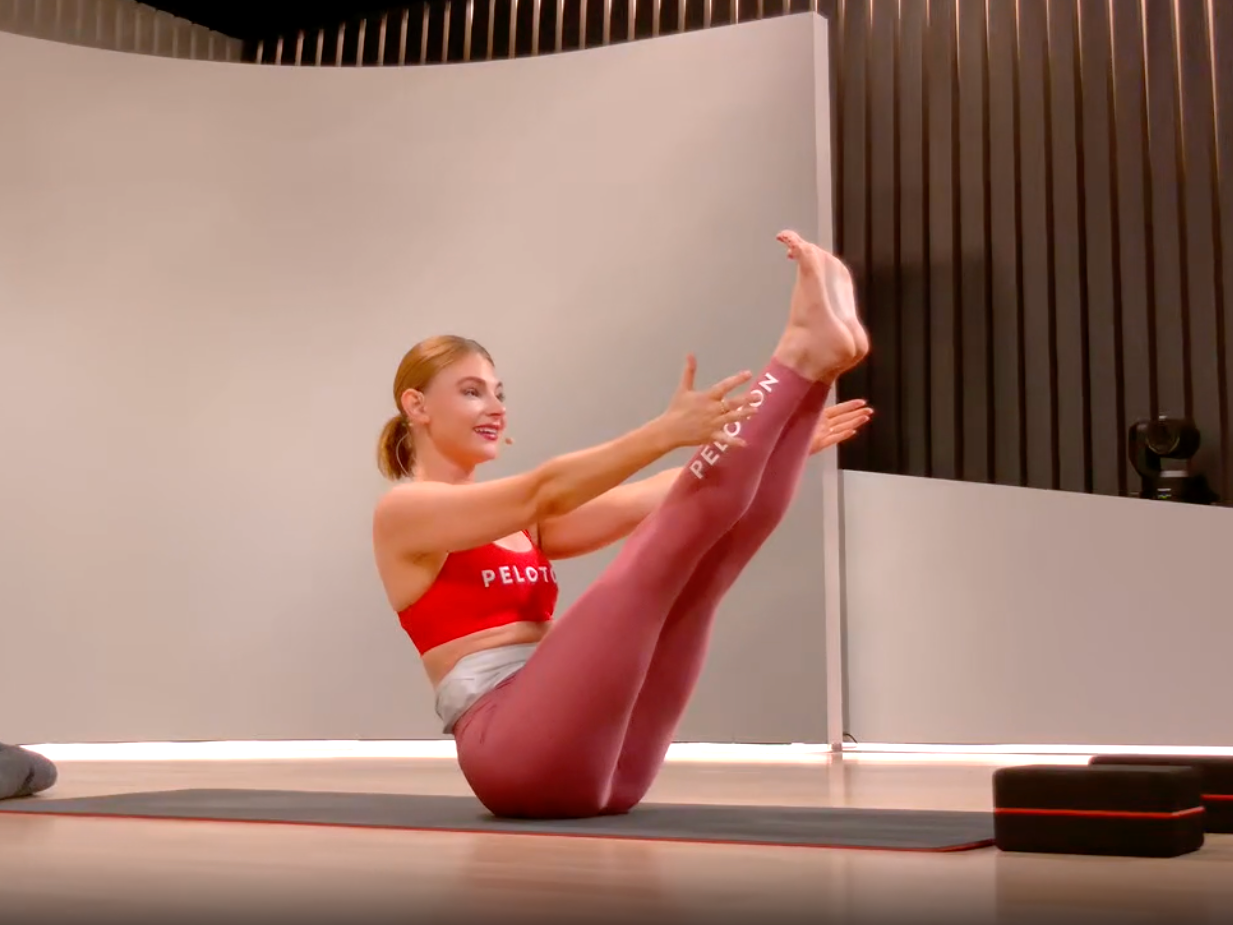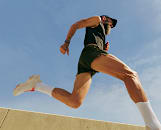
Is Yoga Enough to Build Strength?
A Peloton Yoga expert settles the debate.
By Michele Ross•
Is Yoga Strength Training?
Can You Build Muscle with Yoga?
8 Yoga Poses for Building Strength
Tips for Making Yoga More Challenging
The Takeaway
If you’ve never practiced yoga, you might imagine blissed out and bendy folks sitting, standing, and stretching with total ease and serenity. However, those who have ever taken an Ashtanga or Power Vinyasa class know all too well that yoga can be seriously challenging (all the while eliciting a sense of inner peace, as well). With all those chaturangas, isometric holds, squats, lunges, and the like, you’re likely to feel your muscles quivering both during and after your class. But with that in mind, does yoga count as strength training?
Discover more ways to reach your goals with Peloton
We’ll explore this confounding yet common question below. Plus: if yoga actually builds muscle, if you need additional strength training if you practice yoga regularly, and the best yoga poses to get stronger.
Is Yoga Strength Training?
Despite its fame as a modality that focuses largely on balance, flexibility, and mobility, many types of yoga also count as strength training. “The Vinyasa flows and Power flows are going to be much more efficient in building strength than Restorative and Yin, which are going to be almost entirely focused on mobility and flexibility,” says Peloton instructor Denis Morton.
Yoga typically involves only body weight, which can boost muscular strength and endurance. “By supporting your body weight under tension [i.e., via isometric holds], what results is muscle damage over time,” Denis explains. Once the muscle damage repairs, it turns into strength.
“Yoga has the opportunity to build core strength in poses like Boat Pose and Plank Pose, [as] you're engaging your core and holding it for a long time,” Denis shares as an example. The more you practice these poses, the stronger the integrity of your pose will be and the longer you’ll be able to hold it. Better yet, these wins can also translate to IRL off the mat. Core strength benefits, for instance, include better posture, improved balance and stability, and injury prevention.
Can Yoga Replace Strength Training?
Although yoga can technically count as strength training, you may wish to include other forms of resistance training, such as weightlifting, into your workout regimen.
Some yoga classes will incorporate extra resistance—such as yoga with weights and resistance bands—which can move the needle a bit more to tax your muscles. However, practicing yoga for strength training can only get you so far. According to Denis, the more physically demanding styles of yoga build functional strength (which helps with daily movements like pushing, pulling, and squatting) rather than maximal strength (or the peak capacity of muscle exertion in a single movement, which you’d get via power training,).
In a 2016 randomized controlled trial of healthy yet sedentary adults, an 8-week Hatha yoga program was found to be just as effective as a strengthening and stretching exercises to improve functional fitness, with markers including strength as well as:
Balance
Flexibility
Mobility
“But in order to get real hypertrophy gains and maximal strength gains, you're going to have to pick up free weights,” Denis explains.
That said, yoga is a great complement to weight training. “Yoga will give you the bodyweight strength that we've been discussing, and also maintain range of motion while you're building muscle and strength with a weight program,” he continues. Plus, your Asana practice will lengthen, strengthen, and improve range of motion in the muscles you train (and shorten) on your weightlifting days.
Can You Build Muscle with Yoga?
While yoga can help you get stronger, it’s not the gold standard to build muscle.
“Even in a really vigorous yoga class, maybe you'll get 20 Plank-to-Chaturangas and into an Up Dog. But you're not going to be targeting the same muscle group repetitively in a way that's going to fatigue it to the point that you're going to be building a lot of muscle,” Denis clarifies. Instead, he reminds us that you’ll still be building strength endurance and stability, which can allow you to:
Hold your body weight more comfortably
Hold poses for a longer period of time
Do more reps
If muscle growth is a primary goal of yours, Denis cites Andy Speer’s 4-week Total Strength program as a fantastic option for gains. Of course, you can stream it alongside your favorite yoga classes, whether more active or grounding, on the Peloton App.
“I would personally recommend doing yoga any day that you're not doing [additional] strength, with the exception of maybe giving yourself one full rest day a week,” he adds.
Yoga Benefits
Yoga can serve as one piece of the larger puzzle of your strength training regimen—but that’s far from the only perk that it offers.
For instance, in terms of physical health, a 2015 study of Chinese adults found that a 12-week Hatha yoga program improved not only muscular strength and endurance, but also cardiorespiratory endurance and flexibility compared to a control group. Yoga can also boost exercise performance, no matter if you’re a runner, dancer, seasoned athlete, or casual gym-goer.
The benefits of yoga for mental health can’t be understated, either. Per a 2023 study of female college students in China published in The Journal of Sports Medicine and Physical Fitness, a yoga practice was found to:
Enhance psychological resilience
Improve depression and anxiety
Boost subjective well-being and quality of life
Other research suggests that yoga can reduce stress and improve sleep quality to yield substantial and lasting effects.
8 Yoga Poses for Building Strength
If you’re determined to build strength with yoga, Denis suggests prioritizing the following postures.

1. Chair Pose (Utkatasana)
Chair Pose is more powerful than you may imagine. It simultaneously works your:
Back, shoulders, and arms
Quads, hamstrings, and hip adductors (inner thighs)
Core
Pelvic floor
Calves and ankles
Tip: To make your Chair Pose safe and extra effective, heed Denis’s advice. “If you’re in Chair Pose, the way to maximize your time under tension is to get your hips level with your knees,” he shares. “That will take a little bit of the pressure off the muscle compared to dipping your hips too low. If you lift your hips above your knees, you're also taking the pressure off the muscle.”

2. Warrior 1 Pose (Virabhadrasana 1)
Warrior 1 is included in many yoga sequences. It strengthens your shoulders, core, glutes, and thighs. As with other standing postures, the longer you hold it, the juicier it gets.

3. Warrior 2 Pose (Virabhadrasana 2)
Denis also says that Warrior 2 is great to build strength. Similar to Warrior 1, it helps strengthen your shoulders, core (including your transverse abdominis, aka deep abs, and lower back muscles), glutes, and thighs. At the same time, it stretches your chest muscles, hip flexors, groin, inner thigh muscles, and calves.
4. High Lunge (Anjaneyasana)
High Lunges help strengthen your glutes, quads, and hamstrings. Since it’s a single-leg exercise, it’ll also work your core to maintain your balance.
Tip: When it comes to standing bent-knee postures in yoga (including but not limited to Warrior 1, Warrior 2, and High Lunge), “the closer to 90 degrees you can get your knees, the better,” says Denis.

5. Plank Pose
Plank Pose is one of the most powerful core-strengthening poses in yoga, says Denis. It not only works your deep core but also activates your shoulders, back, glutes, and quads. He adds that Plank to Chaturanga is also great for your upper body including your chest, triceps, and shoulders.
Strength benefits aside, Plank can improve balance, stability, and coordination while also aiding injury prevention.

6. Boat Pose (Paripurna Navasana)
Denis cites Boat Pose as another one of the best yoga postures to work on core strength. It works your rectus abdominis (the top layer of your ab muscles, aka the home of the “six-pack”), transverse abdominis, and obliques (the muscles on either side of your torso).
Core aside, Boat Pose also works:
Your shoulders and arms
Your hip flexors when you extend your legs
Your quads and shins

Mystockimages via Getty Images
7. Crow Pose (Kakasana)
Looking to strengthen your arms? Naturally, practicing arm balances like Crow Pose can help you make progress on this goal. Crow Pose won’t only allow you to build strength in your arm muscles, but also in your wrists and even your fingertips.

8. Handstand (Adho Mukha Vrksasana)
Denis cites Handstand as one of the most powerful yoga poses to strengthen the upper body—not to mention boost balance, enhance focus, and heighten body awareness. Handstand requires you to engage your entire body, so you’ll also benefit from activating your shoulders, core, glutes, and then some.
Tips for Making Yoga More Challenging
Some people turn to yoga for a low and slow flow, while others wish to work on strengthening and lengthening at the same time. (Some of us—myself included—switch things up from one day to the next.) If you’re in the latter camp, heed Denis’s advice below to level up your practice.
Work Your Way In and Up
Above all, Denis suggests staying in the pose no matter how challenging it gets (and how much you want to work your way out of it to give your muscles some sweet relief). At the same time, he advises against pushing yourself too hard.
“Strength is something we build over time, so you don't want to go so intensely or so quickly that you burn out or get discouraged,” he shares. Listen to your body and be cognizant of your limits, which can change from day to day.
Fully Activate the Muscles Worked from One Pose to the Next
A little extra body awareness and muscle engagement can go a long way to build strength from yoga. For instance, Denis advises activating your core in Boat Pose; in Chair, turn your attention to your abs, back, and quads.
“The more you focus on the muscles that you're working while you're working them, the more engagement you'll get and the more efficient activation,” he explains. “Bringing that onto your yoga mat with you is only going to help you focus on the muscles you're using and build strength.”
Add Some Weights
Doing yoga with weights (aka Yoga Conditioning on the Peloton App) can add a fun challenge to your routine. Denis suggests leaning into it without losing focus on which muscles you’re working at a given time.
“When you're bringing in weights, you can add an entirely different element to your practice,” he says. “In something like Warrior 2, if you’re doing small pulses, you could activate the shoulders a little more efficiently.”
The Takeaway
The more vigorous styles of yoga can count as strength training. “Yoga is primarily bodyweight training and isometric training,” Denis reiterates. “If yoga is going to be a primary element of your strength program, consistency is key, just like with everything else. The more consistently you show up and do the work, the better the results will be.” However, it has its limitations.
For instance, people hoping to build muscle will be best served by lifting weights and increasing their load over time, instead of relying on the likes of yoga and bodyweight exercises alone. Still, yoga offers no shortage of benefits for physical, mental, and spiritual health. You won’t want to snooze on the practice if you’re seeking greater balance and flexibility in your body and mind, both on and off your mat.

Peloton App
Access thousands of classes with no equipment needed.
This content is for informational and educational purposes only and does not constitute individualized advice. It is not intended to replace professional medical evaluation, diagnosis, or treatment. Seek the advice of your physician for questions you may have regarding your health or a medical condition. If you are having a medical emergency, call your physician or 911 immediately.
Level up your inbox.
Subscribe for a weekly dose of fitness, plus the latest promos, launches, and events.
By providing your email address, you agree to receive marketing communications from Peloton.
For more about how we use your information, see our Privacy Policy.








